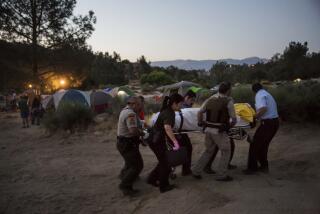Battling Childhood Drowning : County Group Hopes to Educate Parents, Public
- Share via
So far this year, only two Orange County tots have drowned, contrasted with 10 drownings in the first four months of 1986, according to the Orange County Trauma Society.
If they can educate parents and the public to high-risk situations and children, society members hope that 1987 will be the year they change Orange County’s reputation for having among the nation’s highest incidence of childhood drownings, society spokeswoman Dolly Brill said.
“This is the first year we might see a downturn,” Brill said at a conference in Newport Beach this week on the issue. “It would be by word of mouth and constantly keeping people aware of the hazards because the population at risk hasn’t changed.”
Brill was one of more than 40 people, including doctors, bureaucrats, health service representatives and mothers of near-drowning victims, assembled at the two-day conference to discuss strategies for prevention and policy issues in California.
The statistics presented were overwhelming:
Between 1982 and 1985, 46 children under the age of 5 drowned in Orange County, Brill said. In 1986, a record high of 20 children under 5 drowned, including the 10 during the first four months of the year. Of those children, she said, 51% were under 2 years old. Brill said relatively more drownings occur before summer because children are just as interested in water the year round while parents tend to be more concerned in summer and so are less watchful at other times.
By looking at the circumstances in the deaths and near-drownings in past years, Brill said, the society has tried to identify children and situations that pose the greatest risk.
Half of the drownings occurred in residential pools; nine occurred in spas and four in either apartment or condominium pools.
Brill, who is co-chairman of the society’s drowning prevention program, said the information was compiled from death certificates. Not all the certificates listed drowning as the cause of death. She said 19 different medical causes were listed on the certificates examined because drowning is only listed as a cause of death if the child dies within 24 hours.
Usually, a child drowning victim is last seen in the house, not by the pool, as much of the public thinks, according to the findings of a six-county report by the Consumer Product Safety Commission that was presented at the conference.
‘Distraction,’ Not ‘Neglect’
“We’re looking at a distraction,” said Lee Baxter, the commission’s western regional director. “We’re not looking at neglect.”
The experience of Burbank resident Karen Rath, who attended the conference with her 4-year-old daughter Rochelle, a near-drowning victim two years ago, illustrated that conclusion by the CPSC study.
Rath didn’t have a pool, but while she was at a neighbor’s house borrowing a swimsuit for Rochelle for the family’s vacation, one of her worst fears came true, she told the conference.
Rochelle and the neighbor’s son were left in one end of the house while Rath and the boy’s mother went to a room in the other end to look for the swimsuit. Several minutes later Rath saw the neighbor’s dog walk into the house, and she immediately became worried because she knew her daughter and the dog were inseparable.
“I went into the bedroom and all I thought was water and blue,” Rath said. “I turned, ran through the kitchen and hit the screen door.
“I ran to the pool, looked at the bottom, she wasn’t there, and I thought to myself, ‘Silly fool; you overreacted,’ but as I scanned the pool, looking up I saw her floating face down on the other end of the pool,” she said.
Rath said that she and a neighbor performed cardiopulmonary resuscitation while they waited for the paramedics.
Rochelle spent 2 1/2 weeks in intensive care and three months in rehabilitation.
Two years later, Rochelle is not able to walk or crawl, and her balance and speech are still affected, but her mother said her trunk and head control are improving.
“Rochelle represents all of the near-drowners who can’t be here and those who have died,” Rath said. “She should have a quality of life and should have a chance at life. It depends on the adults--they can make the change.”
Near-Drowning
Maureen Ryan from San Jose also related the experiences of her daughter Kimberly’s near-drowning eight years ago.
Ryan said she was talking on the telephone and didn’t notice her daughter had walked out the back door. When she got off the phone and looked for Kimberly, she noticed that the door was open and found her daughter in the deep end of the pool.
Ryan, a nurse, said she jumped in, got Kimberly out and performed CPR. Kimberly was on a respirator for 67 days.
“The rest is more or less a miracle--she recovered,” Ryan said.
After two weeks, Kimberly, then 2, was walking and talking, even though Ryan said doctors had told her that her daughter could never do those things again. It wasn’t until after Kimberly was home for seven months that she became deaf as a side effect of antibiotics, Ryan said.
Kimberly, now 10, goes to a special school for those with a hearing loss.
Solving the child drowning problem is one of three priority projects for the Consumer Product Safety Commission, according to CPSC Commissioner Carol Dawson.
“It will take a concerted effort from all segments--government, industry, the medical community and volunteer associations--both to increase the awareness of the problem and to conduct additional research to identify specific problem areas,” Dawson said.
The CPSC study involved 143 near-fatalities or fatalities of children under 5 in the California counties of Los Angeles, Orange, Fresno, Santa Clara and Contra Costa, the Florida counties of Broward and Dade and Maricopa County in Arizona.
At least one parent was the child’s caretaker in 68% of the cases, and 64% of the incidents occurred in the victim’s family pool.
Of the children studied, 43% were 2 or 3 years of age, and 34% were under 2.
“These are silent events; children are not kicking and screaming,” Baxter explained. “In some cases parents were dozing by the pool, and they didn’t know there was a child in danger.”
Baxter also said this problem affects almost everyone--lower-middle class, upper-middle class and upper-class families.
According to a study by UCLA epidemiology professor Jess Kraus, boys under 3 are at the greatest risk.
Kraus examined death certificate information for almost 5,900 children under 15 who had drowned between 1960 and 1985.
Boys More Likely Victims
In that period, children drowned at an average annual rate of four per 100,000 population, Kraus said. The peak rate was for children under 5, and the greatest number of drownings occurred among children between 1 and 3.
The study also showed that over the period studied, boys were twice as likely to drown as girls, Kraus said. Boys were most likely to drown between the ages of 2 and 3, while girls between the ages of 1 and 2 were at the highest risk, he said.
Kraus’ study found a higher incidence of drownings on Saturdays and Sundays, especially among older children.
Based on her own experience and those of other mothers, Ryan, of San Jose, said she now believes that people who have small children should have some kind of device on them to know where they are all the time, or they should not have a pool.
“My prayer is that there won’t be anymore near-drownings because it’s a needless accident,” she said.
More to Read
Sign up for Essential California
The most important California stories and recommendations in your inbox every morning.
You may occasionally receive promotional content from the Los Angeles Times.










